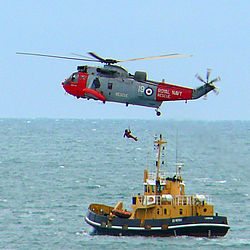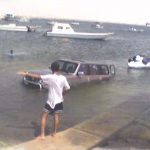It makes good sense to tow another boat with a twisted nylon line of adequate size and dependable integrity, so that the stretch in the line softens any shock to the cleats on both boats. The drawback is that if the line does give way, the stretch in the line will cause it to snap back with great velocity and force. So a good rule to follow is that if there is considerable strain on the line which could cause it to break, (such as in heavy weather) move to a line with less stretch, like dacron. Dacron will be tougher on the cleats because it has no or little stretch, but if it snaps, it won’t fire a lethal missile toward one boat or the other, but should drop harmlessly into the water.
Don’t tow another boat unless you are sure that your cleats and his will take the load and are through bolted with a backing plate. When a cleat is pulled free under strain, it becomes a lethal missile to anyone standing in its path.
A towline should be one that is quickly tied, easily adjusted, and easily cast off. Metal fittings on the towline or bridle can become lethal missiles if the line breaks, so don’t use them. (They can also sink the line into the prop if not properly tended.)
Use a bridle for towing, unless your boat is equipped with a special towing bit or sampson post on the centerline and forward of the rudder. (And I’ll bet it’s not.) The bridle can be attached to your aft cleats if they can be trusted, or to the boat’s lifting hardware which you’ll usually find bolted to the transom. The length of the bridle should be about 3 times the width of your boat.
When you’re heaving a line to another boater or someone ashore, tie one end of the line to a rail or something else on or in the boat, making sure its not underfoot or in danger of getting in the way. With practice, you should be able to toss an unweighted, coiled line at least 30 feet.
When preparing to tow a Personal Watercraft, make sure the air vent in the front cowling is covered. Water from your wake can enter, and sink the disabled PWC. Connect the towline to the trailer eye, and if the operator is aboard, have him/her shift their weight as far back as possible. Consider a “hip tow” in calm waters in tight quarters, and in rough seas, bring the operator on board the towing vessel.
If an aircraft or helicopter is close by, do NOT shine a light directly at it to get the pilot’s attention, regardless of how much trouble you think you’re in. Also, do not shoot a flare in the direction of an approaching aircraft or helo. You can easily blind the pilot, and if you do, your troubles will just be STARTING. Hand-held, automotive type flares work best when you’re trying to get the attention of an aircraft which is in your immediate vicinity.
Practice man-overboard drills with your crew and/or family members. The drill should go something like this….. Yell loudly to alert everyone on board if someone goes overboard, and toss something floatable overboard immediately. Have someone assigned to point at the MOB and keep pointing until the helmsman says its OK to stop pointing. Sound five or more short blasts on the horn (the danger signal) to alert other boats in the area. Approach the MOB upwind or upcurrent slowly until your boat is in a retrieval position, and then shut off the engine. Bring the MOB into the boat over the stern. Practicing this simple drill can save a life.
If you’re on shore, assisting a person in the water, follow these four steps in this order….first REACH for the person, using your arm, a jacket, belt, oar, or a fishing rod. If that doesn’t work….THROW something that will float, like a life cushion, life jacket, plastic bottle, beach toy, ball, thermos jug, or piece of wood. If they are too far away, ROW….using a log, air mattress, surfboard, or anything else you can paddle with your hands. The last option is to GO….the risk of this last resort is that now there are two people in the water, so only go if you are a strong swimmer and have had some training in lifesaving.








